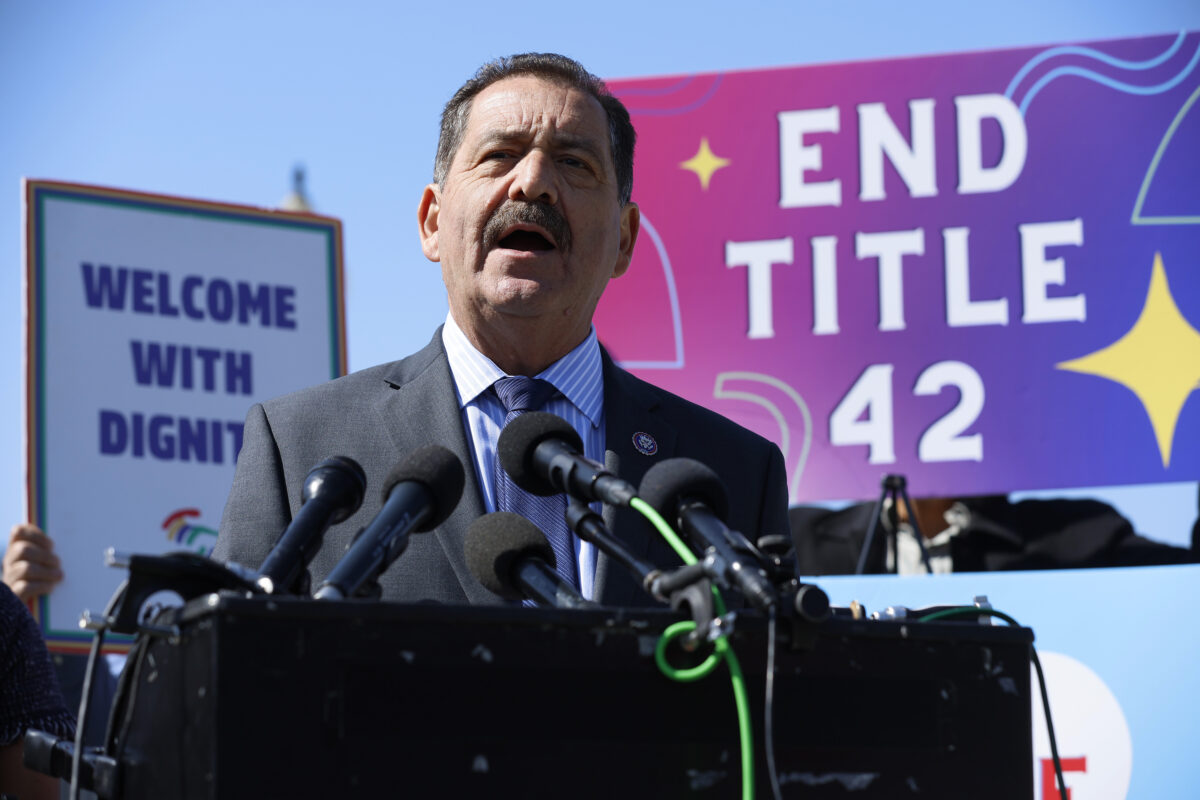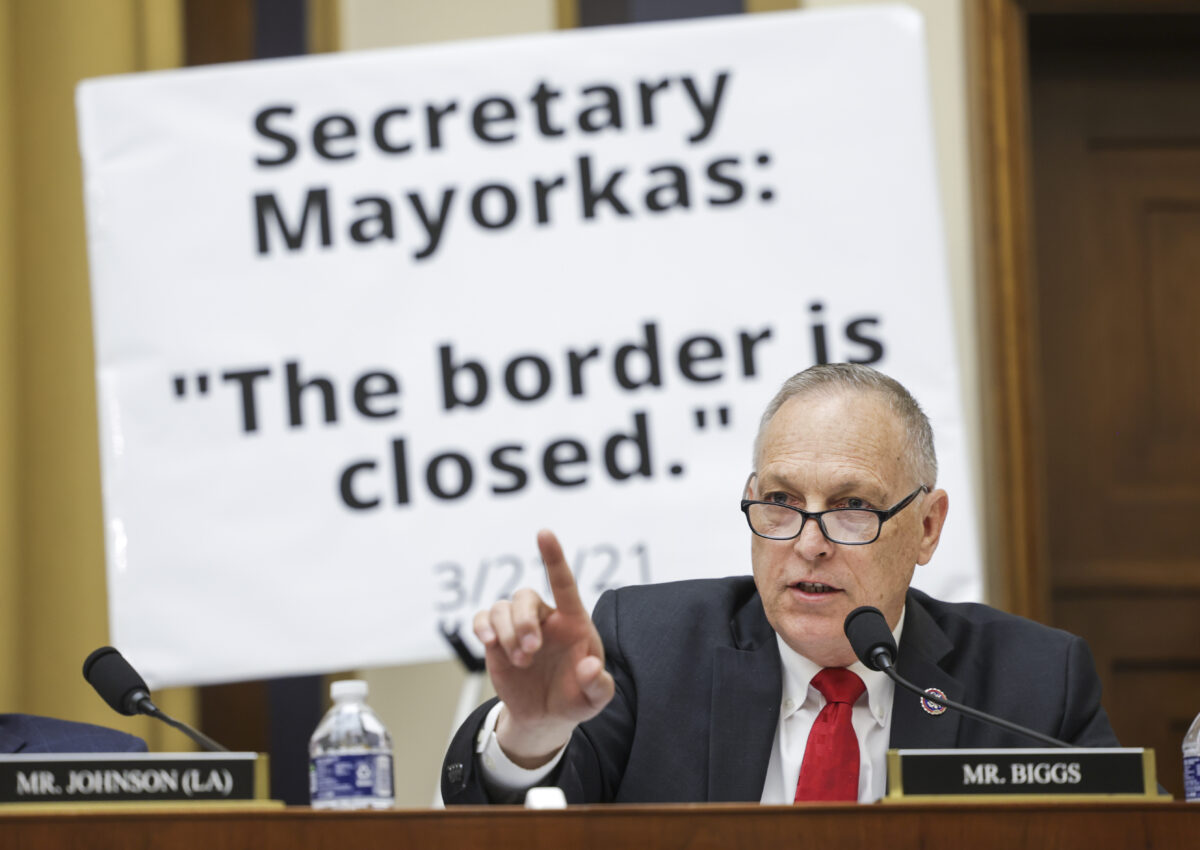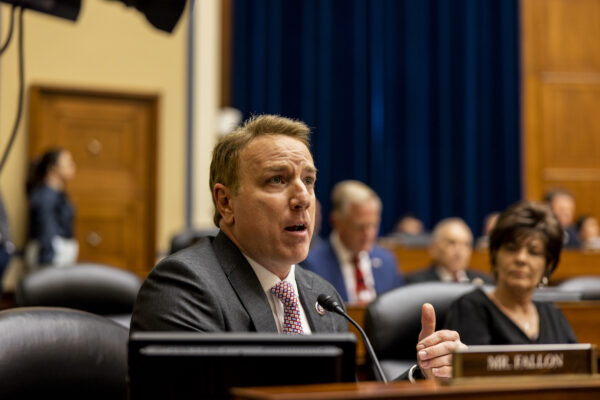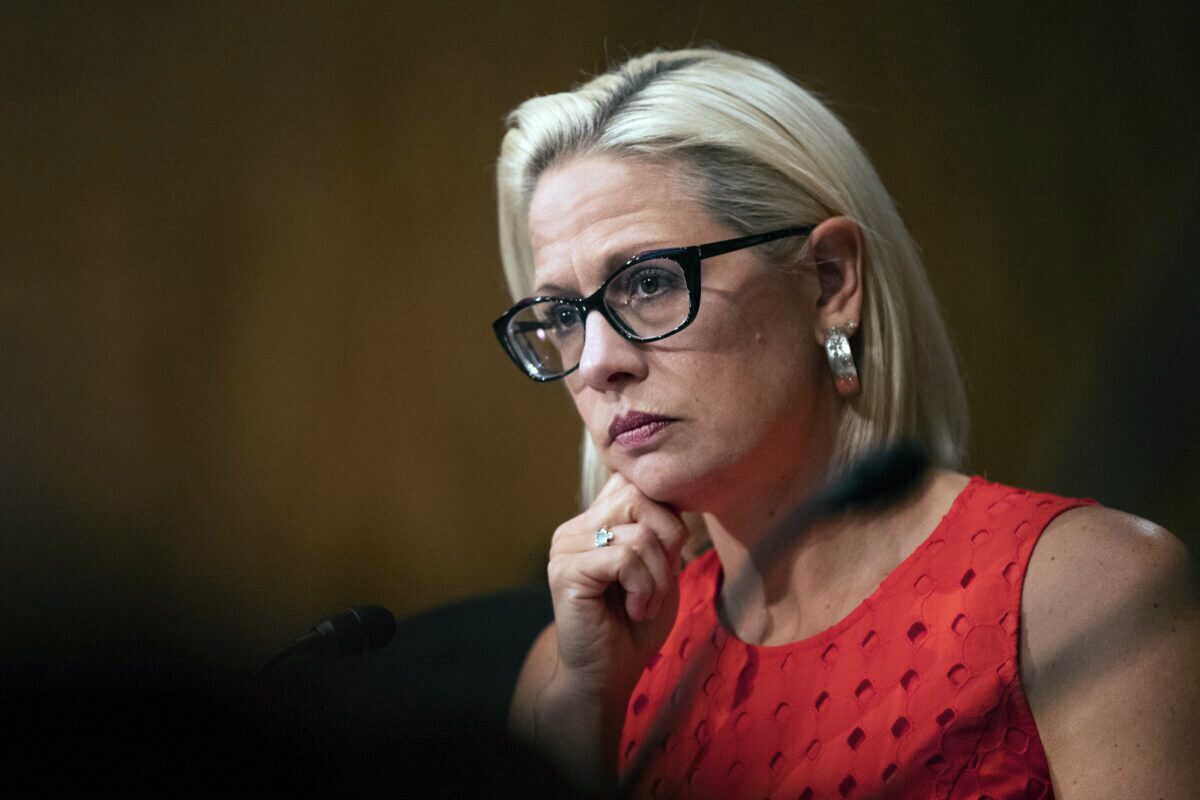Officials Grapple With Border Policy, Brace for Surge of Illegal Immigrants as End of Title 42 Nears
With the Donald Trump administration-enacted Title 42 restriction set to end on Dec. 21, U.S. officials are bracing for a massive surge of illegal immigrants crossing over the southern border.
When the policy disappears in less than two weeks, the Department of Homeland Security estimates that 9,000 to 14,000 migrants could try to enter the country illegally each day.
Created as part of the Public Health Service Act under President Franklin D. Roosevelt in 1944, Title 42 was designed to prevent the introduction of contagious diseases in the United States.
The policy was issued by the Trump administration in 2020 at the beginning of the COVID-19 pandemic.
Migrants processed under the policy are not permitted to request asylum in the United States and are removed from the country.
On paper, Title 42 covers the Canada and Mexico borders and migrants of all nationalities. It has mostly been used along the southern border to remove illegal immigrants from Mexico, Guatemala, Honduras, and El Salvador from the United States.
Almost 2.4 million illegal immigrants were stopped by U.S. agents along the southern border in fiscal year 2022, which ended on Sept. 30.
Federal statistics indicate that more than 1 million of the encounters led to the immigrants being removed from the country under Title 42.
Once Title 42 is lifted, the number of migrants that Border Patrol agents must process will “likely be double or greater,” according to a U.S. Department of Homeland Security Office of Inspector General report released in September.
It is not clear what the Biden administration plans to do when Title 42 is terminated on Dec. 21.
When Biden took office, one of his first actions was ending the “Remain in Mexico” policy implemented under Trump.
Under that law, asylum-seekers were required to remain in Mexico while their asylum claims were processed. Figures showed that the policy discouraged false asylum claims and decreased the number of illegal immigrants.
Blas Nunez Neto is the acting assistant DHS secretary for border and immigration policy. Last month, in a call with Latin American reporters, he said the United States would move to prosecute migrants who attempt to evade Border Patrol agents and deport people who illegally enter the country under expedited removal, a process that includes a five-year ban from the United States.
When Title 42 expires, DHS will transition from Title 42 to Title 8 processing.
Title 8 is a federal law that allows expulsions if illegal immigrants don’t qualify for asylum.
In fiscal year 2022, the U.S. Border Patrol removed 1.1 million under Title 8 compared to around 1 million illegal immigrants under Title 42.
Termination of Title 42
The Dec. 21 termination date was determined by Judge Emmet Sullivan of the U.S. District Court for the District of Columbia, who voided Title 42 on Nov. 15. Sullivan was appointed by former President Bill Clinton.
In his report, Sullivan said that the Centers for Disease Control and Prevention (CDC) did not properly explain the reasons for approving the policy instead of using what he termed as less drastic ways to address the virus.
The CDC also “failed to consider the harm to migrants subject to expulsion,” Sullivan wrote, referencing reports claiming that migrants could be persecuted in Mexico and other countries after their expulsion from the United States.
On Nov. 16, Sullivan gave federal immigration officials five weeks to end Title 42.
Sullivan’s decision stemmed from legal action filed by the American Civil Liberties Union (ACLU), which argued that Title 42 endangers migrants and violates asylum law.
Even if their arrival is illegal, migrants who cross the border onto U.S. soil can request asylum, which provides humanitarian protection.

Hours after Sullivan announced his ruling, Justice Department lawyers asked the federal judge to delay the decision for five weeks on the grounds that abruptly eliminating Title 42 would create operational issues and not offer enough time to coordinate an “orderly transition” to regular immigration processing.
Referring to the Department of Homeland Security, Justice Department lawyers wrote, “This transition period is critical to ensuring that DHS can continue to carry out its mission to secure the Nation’s borders and to conduct its border operations in an orderly fashion.”
Sullivan granted the request “with great reluctance” and said the order voiding Title 42 would become effective on Dec. 21 at midnight.
On Dec. 7, the Biden administration announced it would appeal the court ruling, believing that the CDC would issue new orders regulating migration.
The appeal contradicts the Biden administration’s previous support of lifting the policy.
Lawsuit to Keep Title 42
After taking office in January 2021, the Biden administration maintained the Trump-enacted Title 42 for more than a year until announcing it would gradually end the expulsions, claiming they were no longer needed because of improved conditions with the pandemic.
A group of 24 Republican-led states responded by filing a lawsuit to keep Title 42 in place. The group said that stopping the policy would result in “a surge of border crossings and that this surge will result in an increase in illegal immigrants residing in the states.”
The higher number of immigrants would increase the amount of money required to spend on education, health care, and law enforcement, officials from many of the states argued.
In May, U.S. District Court Judge Robert Summerhays temporarily blocked the Biden administration from voiding Title 42. Summerhays was appointed by Trump.
Sullivan’s ruling on Nov. 15 superseded the May decision.
In July, the Biden administration appealed that ruling but kept relying on Title 42 as a border management policy.
It expanded Title 42 guidelines to include Venezuelan migrants in October in an attempt to deter the wave of Venezuelan migration to the southern border.
That decision also approved what the Biden administration calls a humanitarian parole plan that allows up to 24,000 Venezuelans a legal pathway to the United States.
In a July deposition, Border Patrol Chief Raul Ortiz was asked if the Biden administration signaling that it won’t enforce border laws will result in “exponential” increases of illegal immigration. He responded, “I do think it will increase, yeah.”
Ortiz was asked if the southern border is “currently in crisis,” and if there is an “unprecedented” number of people illegally entering the United States. He said “yes” to both questions.
‘The Border Is Secure’
Ortiz’s comments contradicted what Homeland Security Secretary Alejandro Mayorkas said a week before at the Aspen Security Forum in Colorado.
“Look, the border is secure,” Mayorkas said. “We are working to make the border more secure. That has been a historic challenge.”
On Nov. 17, Mayorkas told legislators that the department will explore ways to prevent Venezuelan migrants from entering the United States through the southern border if Title 42 ends.
Sen. James Lankford (R–Okla.) asked Mayorkas about the administration’s strategy to deal with Title 42’s conclusion.
“We’re still waiting to try to figure out what happens now and how many are about to cross the border. What’s the plan for dealing with this massive migration, illegal immigration coming now post-Title 42?” Lankford said at the Nov. 17 Senate Homeland Security Committee hearing.

“What we are doing is precisely what we announced we would do in April of this year, and we have indeed been executing on the plan,” Mayorkas responded.
The plan includes sending personnel, technology, and other resources to the border and increasing processing efficiency “to mitigate potential overcrowding,” Mayorkas explained.
“We are enhancing the consequences for unlawful entry, especially with respect to individuals who seek to evade law enforcement, including removal, detention, and criminal prosecution when warranted,” Mayorkas added.
The entire hemisphere is suffering a migration crisis, Mayorkas explained.
“We are seeing an unprecedented movement of people from country to country,” he told lawmakers at the hearing. “It is not restricted to the southern border.”
At the hearing, Mayorkas maintained his belief that “the border is under control.”
Republicans, Democrats Seek Solutions
Republicans are poised to take control of the House in January 2023 and have said that securing the border will be a top priority, as will holding the Biden administration accountable for the illegal immigration crisis.
In a press conference in El Paso, Texas, on Nov. 22 while touring the southern border, GOP House Minority Leader Kevin McCarthy called for Mayorkas to resign or face potential impeachment.
“His actions have produced the great wave of illegal immigration in recorded history,” McCarthy said. “This is why today I am calling on the secretary to resign.
“He cannot and must not remain in that position,” he said. “If Secretary Mayorkas does not resign, House Republicans will investigate every order, every action, and every failure to determine whether we can begin an impeachment inquiry.”
Mayorkas has no plans to resign, the DHS said, adding that the Biden administration inherited a broken and dismantled immigration system that is the job of Congress to repair.
“Members of Congress can do better than point the finger at someone else; they should come to the table and work on solutions for our broken system and outdated laws, which have not been overhauled in over 40 years,” a DHS spokesperson said.
On Nov. 21, 15 Republican-led states filed a federal court motion seeking to reverse Sullivan’s termination of Title 42.
Attorneys general from Alabama, Alaska, Arizona, Kansas, Kentucky, Louisiana, Mississippi, Nebraska, Ohio, Oklahoma, South Carolina, Texas, Virginia, West Virginia, and Wyoming wrote that Biden administration officials “abandoned their defense” of the policy by asking only for a five-week suspension of Sullivan’s ruling and not appealing Sullivan’s order.
The end of Title 42 will lead to greater numbers of migrants crossing the U.S.-Mexico border illegally and would harm their states financially, including costs of social services for immigrants, the Republican attorneys general argued.
If Sullivan’s ruling is suspended, the Dec. 21 termination date could again shift. The Republican-led states that brought the lawsuit could ask the D.C. Circuit Court of Appeals and the U.S. Supreme Court to intervene if Sullivan denies the motion.
Earlier this week, Rep. Pat Fallon (R-Texas) introduced the American Safety and Fairness Through Expedited Removal (SAFER) Act.

If passed, this measure would expand the use of expedited removal, which debuted under Clinton’s administration and allows DHS to swiftly remove illegal immigrants without a hearing if they have not been in the country for more than two years.
The process is presently limited to illegal immigrants who are apprehended within 100 miles of the southern border or have crossed into the United States within two weeks.
Fallon’s proposed legislation would eliminate those guidelines and would require all illegal immigrants to be removed from the country if they did not get valid entry documents and have been in the United States for less than two years.
“As CBP braces for a monumental migration event due to the impending expiration of Title 42, we as members of Congress must act to counter Biden’s Border Crisis,” Fallon said. “That is why my colleagues and I are introducing the American SAFER Act.
“No more will illegal aliens receive a get out of jail free card from the expedited removal process because they’ve traveled 100 air miles into the interior of the United States,” Fallon added. “It’s time to restore this important tool for border patrol and immigration authorities.”
The bill has 17 co-sponsors and support from the Federation for American Immigration Reform.
“President Biden’s failed policies are crushing our southern border,” Rep. Mark Green (R-Tenn.) a co-sponsor of the bill, said in a statement. “This legislation is a huge step forward in ensuring those who illegally enter our country cannot circumvent the law and are swiftly removed.”
Arizona Sens. Kyrsten Sinema, who recently announced that she was leaving the Democratic Party and becoming an Independent, and Mark Kelly, who is a Democrat, have been outspoken about their belief that Title 42 should remain in place.

In April, they introduced legislation intended to require the Biden administration to have a comprehensive plan ready before rescinding Title 42.
On Nov. 28, Sinema and Kelly joined Sens. Maggie Hassan (D-N.H.) and Jon Tester (D-Mont.) in sending a letter to Mayorkas expressing their concerns about the removal of Title 42.
“While Title 42 expulsion totals reflect repeat attempts to enter the United States, a sharp end to Title 42 would nonetheless significantly increase the number of migrants apprehended along the Southwest Border under Title 8,” the senators wrote.
On Dec. 5, Sinema and Sen. Thom Tillis (R-N.C.) agreed on an immigration reform draft framework that would include a continuation of Title 42.
The proposal features an increase in resources to expedite the intake of asylum seekers with new processing centers, asylum officers, and judges.
The framework also includes increased resources to expedite the removal of migrants who don’t qualify for asylum and more funding for border officers.
If processing centers, which would house migrants, are opened and running, Title 42 would end after at least one year, according to the proposal. The bipartisan effort also contains a plan for citizenship for 2 million undocumented young people who arrived in the United States as children and are known as “Dreamers.”
Multiple Republicans oppose the plan. McCarthy has said any form of amnesty is a “non-starter” in the next Congress.
" Conservative News Daily does not always share or support the views and opinions expressed here; they are just those of the writer."







Now loading...